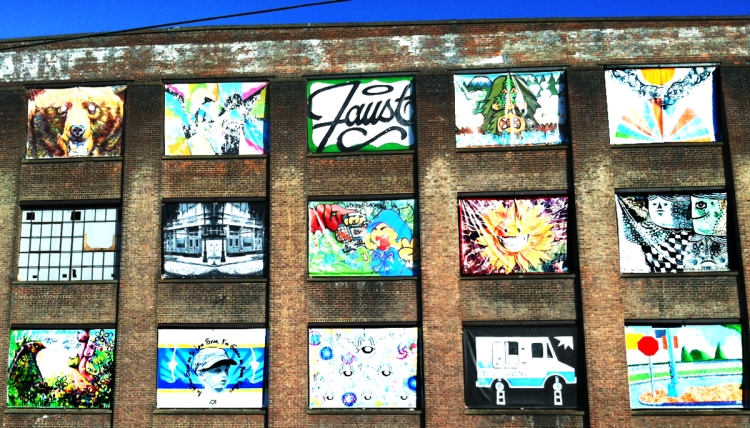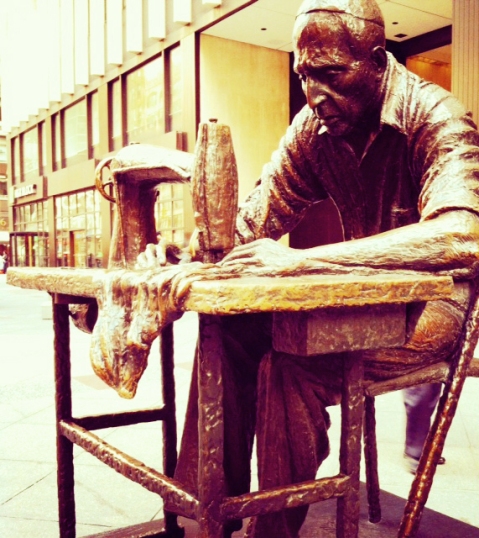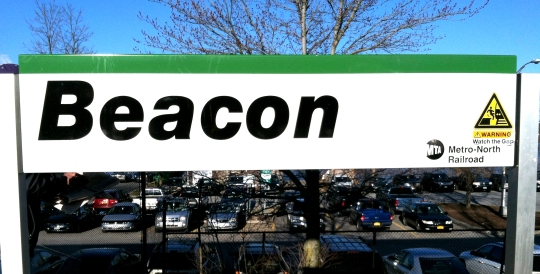BEA-CON [bee-kuhn] – A guiding torch for the world weary traveler, also the name of a town in New York State that lies sixty miles north of New York City…

The town was originally named for the mountainous terrain that lies just southeast of the main thoroughfare. During the Revolutionary War, the Continental Army set fires at the peak of Mount Beacon to deliver warnings to their fellow soldiers. Since then, the landscape has endured many incarnations, highs and lows, much like the topography itself. Nestled within the heart of the Mid-Hudson Valley, Beacon, New York is a ten minute drive from my childhood home, where my parents are currently spending their post-professional careers. Thirty years ago, the once young-ish couple was drawn to the area by an old house at the top of a hill and the opportunity that such a vast amount of space has afforded their artistic temperaments. The basement was turned into a workshop, a small corner of the attic became a dark room, the turn-of-the-century carriage house was set up as an art studio, and the rest of the property was utilized to showcase art, both original and treasured discoveries.
Over the thirty years I have spent coming and going from the region, there have been many changes to the scenery. Woodbury Commons is now the ultimate shopping destination, the Newburgh waterfront boasts fine dining, and Beacon is living up the promise of its name. It is not the same place that I remember from my youth when there were only three reasons to venture over to the once deserted streets: the ballet studio, the DMV, and the escape to Manhattan via Metro North.

The origins of Beacon’s resurgence can be traced back to May of 2003, when the Dia Art Foundation transformed a former Nabisco printing facility into the museum that stands there today. During my visit I saw a collection of works by Richard Serra, including his “Torqued Ellipses,” massive sculptures that would be difficult to exhibit on the island of the spatially challenged. The Dia’s website describes them as “the result of a four year project that experimented with new ways of rolling steel and take the shaping of space rather than material as their primary subject.” It is works such as these that created the demand for the Beacon outpost, as ultimately it is Manhattan’s lack of breathing room that caused people to flee with the same urgency with which they first arrived.

The Dia’s industrial architecture, along with the skylights overlooking wide and generous square footage creates a unique opportunity for viewing large scale contemporary art. Coupled with its close proximity to the Hudson River and the train station, the location proves to be ideal. Now ten years later, the Dia Art Foundation will host a celebration of its decade long anniversary on May 19th, 2013.
The museum’s presence has had a rippling effect that can now be measured by the growing number of businesses along Main Street. The re-purposing of the street level facade is an ongoing process that has created a unique opportunity for gallerists, restauranteurs and other small business owners. Thus far, the bulk of the restoration can be found at the two far ends of the strip, while the middle section is still in the process of becoming.

Just as artists played a vital role in the revitalization of Soho, Chelsea, and Williamsburg, they have now discovered this burgeoning enclave. During the weekend of April 27th over 80 local artists opened up their studios to the public, the “field of dreams” for the creative set. “Imagine it and they will come!”

The NYC based architectural firm Rockwell Group designed the renovation of a cluster of abandoned brick buildings, helping to aid their transformation into The Roundhouse. The upscale restaurant, lounge, event space, and boutique hotel, offer refuge to those looking to turn their day trip into a weekend long retreat. Because many buildings were simply deserted, they maintain their original integrity. Part of the appeal of Beacon and its surrounding area is the architecture of the homes and businesses that strike a balance between what is modern, unique, and aged to perfection.

It is worth mentioning that these new businesses are owned by families and individuals who live in the area and imbue their establishments with an inviting atmosphere. The town has metropolitan grade coffee but no Starbucks, waterfall adjacent dining but no McDonald’s, and the last time I was there, the sound of an acoustic guitar wafted from “Hudson Beach Glass.” Walking down Main Street, I got the feeling that I could be discovering the sixth borough of our great bustling metropolis.
While “Beacon’s Return” is a story about the creative spirit and its ability to rejuvenate an entire town, there was nothing exceptional about the demise from which the revival occurred. Anyone who is familiar with Michael Moore films probably knows that Flint, Michigan, began its epic decline once General Motors started outsourcing its car manufacturing, taking jobs and the local economy along with it. Substitute hats and textiles for cars and that nearly sums up Beacon’s spiral into obscurity.

We are all familiar with some of the effects of outsourcing, but rarely does the media focus on the degrading effect that manufacturing overseas has on the cities and towns that have been abandoned for cheaper pastures. To imagine Beacon’s former prosperity, one has to remember a time before the majority of our manufacturing moved to foreign soil.

-Alan Watts from The Book on the Taboo Against Knowing Who You Are
This is precisely what my mother is rebelling against with her shopping choices. One of the side effects to our culture’s youth obsession is that the aging process is considered shameful, whether in regards to people, buildings, or our most beloved possessions. It is often considered best to discard what’s old and start anew. Given that my mom is someone who has only been made better by her ample life experiences, this sort of thinking will not suffice. Her latest find in Beacon is the shoe cobbler at “John’s Shoe Repair,” who was able to restore a pair of handmade booties made of the finest Italian leather, which she was unable to find its equivalent at any price. She once said that “they demonstrated how a master craftsman understands the anatomy of the foot, that the shoe must be able to do its bidding, and move almost as freely as if it were bare.” It also demonstrates how only something that was made well in the beginning could have any hopes of being later restored.
While Beacon is recovering from its economic depression, others are still suffering through theirs. We live by trial and error and unfortunately we don’t always know the consequences of our decisions until it’s too late. That coupled with greed is the root of our sustainability problem, but it is not just the depletion of natural resources that is an issue. China is no longer the solution for a low-wage work-force, and Bangladesh has positioned itself to take up the reins.
“China is at a crossroads, reinventing itself from a manufacturing powerhouse to a consumer-oriented economy…Since China entered the WTO, tens of millions of Chinese workers have been willing to toil for low wages making the products the rest of the world loves like Nike Air Jordans and Apple phones for cheap prices. This has allowed middle class Americans and Europeans to enjoy an increase in standard of living unparalleled in history… Now that wages and rents are rising, China is going to become an inflationary force on the global economy.”
– Shaun Rein, author of The End of Cheap China

When we think of foreign labor, what often comes to mind are sub-par working conditions. We all have vague notions of the expensive human cost of our low price merchandise, but the recent collapse of a factory in Bangladesh brought the image into much sharper focus. In the case of the building that no longer stands, “Raza Plaza” is an example of architecture that turned out to be just as transient as the clothing it churned out. What’s worse is that it is not an isolated incident, just the most horrifying with a death toll of one thousand and rising. It happened a week before International Worker’s Day, also known as May Day, which was supposed to be a day of recognition for the men and women who produce the material comforts enjoyed by the rest of the world. But instead of leisure, the city of Savar was still reeling from tragedy, and Labour Day became a rallying cry for workers. While the people of Bangladesh were clamoring for improved working conditions, protests broke out all over Europe in response to their persistent unemployment, evidence of unrest on both sides of the labor equation: those who have jobs and those without.
“I think of how many, and not just young people, are unemployed, many times due to a purely economic conception of society, which seeks selfish profit, beyond the parameters of social justice.”
– Pope Francis on May Day in St. Peter’s Square
For better and worse, our countries are all intertwined and we are alike in our struggles, cursing the loss of life and opportunity. There is some irony in the fact that for years, American companies felt that they were getting the better end of the deal and now it is China’s economy that stands to benefit, proving that “you get what you pay for.” The United States has little in the way of a middle class any more, which can be attributed to a small percentage of the population enjoying a disproportionate amount of wealth. It is often easy to blame large corporations, but it is not without the consumer as a willing accomplice. It is easy to forget that the 1% relies on the buying habits and lifestyle choices of everyone else.

There are companies who still do some of their manufacturing domestically and while that number could increase, it is too late to go back to the way things used to be. We must find other ways to invest in ourselves and each other and Beacon has managed to do just that. The Dia helped change the town’s image, small businesses are reviving its local economy, and there is a growing sense of community, which is perhaps the most valuable asset of all.
“I want to turn the clock back to when people lived in small villages and took care of each other.”
– Pete Seeger, longtime Beacon resident

Traveling to Beacon, New York : Trains depart frequently from Grand Central Station, service to Beacon via the Poughkeepsie bound Metro North Hudson Line

Author : Ashley Rabin
RELATED ARTICLES:
Surviving Hell in a Bangladesh factory collapse
Think Tank: Fashion Industry’s “Moral Imperative” (the online version of the article in only available to WWD subscribers, article also appears in the print version from May 6th, 2013)
Thousands rally against European austerity on May Day
Upscale China fast replacing cheap China
PART II: SIREN’S CALLING





This is a great piece. I am fairly new to Beacon (3 years) however, I love this town.
LikeLike
Absolutely wonderful piece! Beacon is an amazing and dynamic town and you captured it so beautifully!
LikeLike
Moved up 20 years ago…never regretted it. I am happy to say that I now have a business on Main Street and love interacting with other shop owners, visitors and residents! Can’t imagine living (or working) anywhere else now!
LikeLike